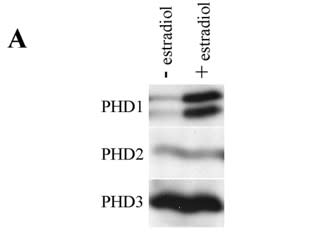Cat. #151314
Anti-PHD2 [366G/76/3]
Cat. #: 151314
Sub-type: Primary antibody
Unit size: 100 ug
Availability: 1-2 weeks
Target: Prolyl Hydroxylase 2 (PHD2)
Class: Monoclonal
Application: FACS ; IHC ; WB
Reactivity: Human
Host: Mouse
£300.00
This fee is applicable only for non-profit organisations. If you are a for-profit organisation or a researcher working on commercially-sponsored academic research, you will need to contact our licensing team for a commercial use license.
Contributor
Inventor: Helen Turley
Institute: University of Oxford
Tool Details
*FOR RESEARCH USE ONLY
- Name: Anti-PHD2 [366G/76/3]
- Clone: 366G/76/3
- Tool sub type: Primary antibody
- Class: Monoclonal
- Conjugation: Unconjugated
- Molecular weight: 46.1 kDa
- Strain: Balb/c
- Reactivity: Human
- Host: Mouse
- Application: FACS ; IHC ; WB
- Description: 366G/76/3 recognises human prolyl hydroxylase 2 (PHD2), a 46kDa enzyme expressed abundantly in all tissues with the highest expression in testis
- Immunogen: Residues 1-24 of PHD2
- Isotype: IgG1
- Myeloma used: P3/NS1/1-Ag4.1
- Recommended controls: MCF7 cells
Target Details
- Target: Prolyl Hydroxylase 2 (PHD2)
- Molecular weight: 46.1 kDa
- Tissue cell line specificity: MCF7 cells
- Target background: Hypoxia inducible factor-1 (HIF-1) is a transcriptional complex, consisting of an alpha and beta subunit, which plays a key role in coordinating the cellular response to hypoxia. During normal oxygen conditions, the alpha subunit of HIF-1 is rapidly degraded, however when hypoxia occurs this degradation is suppressed and HIF-1 activates the transcription of various genes important for survival and adaptation to hypoxia. Prolyl hydroxylase 2 catalyses the hydroxylation of specific prolyl residues within the HIF-1 alpha subunit, thereby targeting this subunit for degradation.
Applications
- Application: FACS ; IHC ; WB
Handling
- Format: Liquid
- Concentration: 1 mg/ml
- Unit size: 100 ug
- Storage buffer: PBS with 0.02% azide
- Storage conditions: -15° C to -25° C
- Shipping conditions: Shipping at 4° C
Related Tools
- Related tools: Anti-PHD1 [PHD112/G7] ; Anti-PHD3 [EG188e/d5]
References
- Jubb et al. 2009. Br J Cancer. 101(10):1749-57. PMID: 19844231.
- Expression of delta-like ligand 4 (Dll4) and markers of hypoxia in colon cancer.
- Soilleux et al. 2005. Histopathology. 47(6):602-10. PMID: 16324198.
- Use of novel monoclonal antibodies to determine the expression and distribution of the hypoxia regulatory factors PHD-1, PHD-2, PHD-3 and FIH in normal and neoplastic human tissues.
- Stolze et al. 2004. J Biol Chem. 279(41):42719-25. PMID: 15302861.
- Appelhoff et al. 2004. J Biol Chem. 279(37):38458-65. PMID: 15247232.
- Genetic analysis of the role of the asparaginyl hydroxylase factor inhibiting hypoxia-inducible factor (FIH) in regulating hypoxia-inducible factor (HIF) transcriptional target genes [corrected].
- Differential function of the prolyl hydroxylases PHD1, PHD2, and PHD3 in the regulation of hypoxia-inducible factor.




